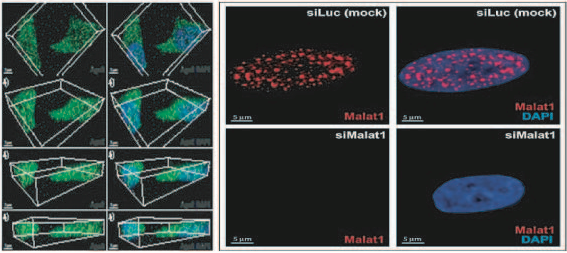We are interested in a wide spectrum of projects at the interface of chemistry and biology. One primary focus is the study of how nucleic acids and nucleic acid mimics recognize target molecules inside cells. Our goal is to develop new strategies for manipulating gene expression that will 1) provide insights into important natural processes and how they are regulated by endogenous nucleic acids, 2) facilitate laboratory research, and 3) lay the foundation for drug development.
Project 1
Function of Argonaute and Small RNA-Dependent Pathways in Mammalian Cell Nuclei.

Argonaute-bound microRNAs and other small RNAs exist in the nucleus of human cells, as do Argonaute and other RNAi factors. Their natural roles in mammalian cell nuclei are unclear. Our hypothesis is that RNAi factors and small RNAs are in the nucleus to regulate important pathways like gene expression.
Current research projects include:
- Identifying nuclear small RNAs and long RNAs that associate with Argonaute
- Biochemical characterization of Argonaute and RNAi factor activity in the nucleus
- Discovery of novel nuclear Argonaute interacting factors
Project 2
Mechanism of promoter-targeted antigene RNAs.
We have observed that duplex RNAs can target sequences within gene promoters and either repress or activate gene expression in culture human cancer cells. These studies suggest that double-stranded RNA can recognize sequences within chromosomal DNA and that RNA-mediated control of gene expression is even richer than had been previously imagined.
Current research projects include:
- Investigating the molecular mechanism of activating and repressing agRNAs
- Searching for naturally occurring agRNAs
- Studying the effect of chemical modifications on agRNA activity
Project 3
Allele-Selective Inhibition of Huntingtin Protein Expression

The expression of mutant huntingtin causes Huntington's disease, a devastating neurological disorder. The gene encoding mutant huntingtin is characterized by expanded numbers of the nucleotide triplet CAG. Our hypothesis is that chemically modified nucleic acids will be able to efficiently inhibit the expression of huntingtin and discriminate between mutant and wild-type alleles.
Current research projects include:
- Allele-selective inhibition with antisense oligos, siRNAs, and single-strand siRNAs
- Mechanism of allele-selective inhibition
- Targeting other repeat expansion disorders
Project 4
Recognition of RNA and DNA by Chemically Modified Nucleic Acids and Locked Nucleic Acids.
Nucleic acid analogs like LNA and PNA are powerful tools for complementary hybridization. They bind cognate sequences with high specificity and high affinity.
Current research projects include:
- Mechanism of promoter-targeted LNAs, PNAs, and other chemically modified nucleic acids
- Optimization of intracellular delivery of PNAs and small nucleic acids
Join Our Lab
The Corey Lab is looking for highly motivated graduate students and postdocs to join the team.